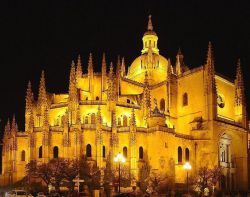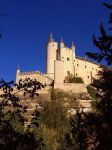Common description
Segovia (Spanish: Segovia) is a city in Spain with a population of about 55 thousand inhabitants. It is the administrative center of the province of the same name in Segovia in Castile and Leon. Segovia is located 90 km northwest of Madrid on a rocky hill between the rivers Eresma and Clamores. Together with Toledo and Avila, it is one of the three famous ancient cities around the Spanish capital.
Segovia is located very well on a rocky plateau at an altitude of 1000 meters above sea level, at the confluence of two rivers. This place was not overlooked by the Romans, who built their famous aqueduct here, nor in time, nor the Arabs, who turned it into a fortress. After the liberation of the city from Moorish rule, the future Queen Isabella was crowned king in the royal palace of Segovia. In Segovia were the courts of Kings Juan II and Enrique IV. To them Segovia owes its splendor.
The atmosphere of the past is preserved in the city, beautiful monuments, gilded churches, ancient fountains and courtyards attract both natives and guests of the city. The Golden Age did not last long: King Charles V did not like the aristocracy of Segovia and lost interest in the city. Only with the coming to power in the XVIII century of the Bourbon dynasty proud Segovia regained royal greatness. Until now, not lost its charm Segovia remains a symbol of Spanish aristocracy.
The Roman aqueduct is the most beautiful monument in the city. It was built during the reign of Emperor Trajan and has been supplying the city with water for three thousand years. The stone blocks are not fastened together. This aqueduct is depicted on the coat of arms of the city.
The cathedral - one of the most majestic Gothic buildings in Spain - was opened in 1558. It still retains its charm.
The Royal Palace - Alcazar - looks like a medieval fortress, although after the fire of 1828 it was reconstructed and repaired. Located on the outskirts of the city. The Alcazar has many underground rooms and secret passages that reach the river and are connected to other palaces of the city. Even today, research into the secrets of the Alcazar is still ongoing. In 1587 was the last reconstruction of the palace. In 1764, Charles II founded the legendary Royal School of Artillery here. Wonderful Throne and Armory halls, where you can feel the atmosphere of the old fortress, within the walls of which history took place.
The Gothic monastery of del Parral was founded in 1447 by Enrique IV and the Marquis de Villena. On the facade of the building - two coats of arms of the Marquis. The interior of the church consists of one nave.
The Church of St. Millie was built around 1120 during the reign of Alfonso I of Aragon. It has a beautiful capitol and a tower with arches. The interior is made in the style of Mudejar XII century.
Church of La Veracruz was founded by the Knights Templar in the XII century. At the heart of the plan is a circle that is quite rare.
The Church of San Esteban (St. Stephen) was built in the early thirteenth century. It has one of the tallest towers in Spain - 53 meters high. The interior of the church was restored after a fire in the style of the XVIII century.
Segovia is located very well on a rocky plateau at an altitude of 1000 meters above sea level, at the confluence of two rivers. This place was not overlooked by the Romans, who built their famous aqueduct here, nor in time, nor the Arabs, who turned it into a fortress. After the liberation of the city from Moorish rule, the future Queen Isabella was crowned king in the royal palace of Segovia. In Segovia were the courts of Kings Juan II and Enrique IV. To them Segovia owes its splendor.
The atmosphere of the past is preserved in the city, beautiful monuments, gilded churches, ancient fountains and courtyards attract both natives and guests of the city. The Golden Age did not last long: King Charles V did not like the aristocracy of Segovia and lost interest in the city. Only with the coming to power in the XVIII century of the Bourbon dynasty proud Segovia regained royal greatness. Until now, not lost its charm Segovia remains a symbol of Spanish aristocracy.
The Roman aqueduct is the most beautiful monument in the city. It was built during the reign of Emperor Trajan and has been supplying the city with water for three thousand years. The stone blocks are not fastened together. This aqueduct is depicted on the coat of arms of the city.
The cathedral - one of the most majestic Gothic buildings in Spain - was opened in 1558. It still retains its charm.
The Royal Palace - Alcazar - looks like a medieval fortress, although after the fire of 1828 it was reconstructed and repaired. Located on the outskirts of the city. The Alcazar has many underground rooms and secret passages that reach the river and are connected to other palaces of the city. Even today, research into the secrets of the Alcazar is still ongoing. In 1587 was the last reconstruction of the palace. In 1764, Charles II founded the legendary Royal School of Artillery here. Wonderful Throne and Armory halls, where you can feel the atmosphere of the old fortress, within the walls of which history took place.
The Gothic monastery of del Parral was founded in 1447 by Enrique IV and the Marquis de Villena. On the facade of the building - two coats of arms of the Marquis. The interior of the church consists of one nave.
The Church of St. Millie was built around 1120 during the reign of Alfonso I of Aragon. It has a beautiful capitol and a tower with arches. The interior is made in the style of Mudejar XII century.
Church of La Veracruz was founded by the Knights Templar in the XII century. At the heart of the plan is a circle that is quite rare.
The Church of San Esteban (St. Stephen) was built in the early thirteenth century. It has one of the tallest towers in Spain - 53 meters high. The interior of the church was restored after a fire in the style of the XVIII century.
Segovia on map
+ 13°C





